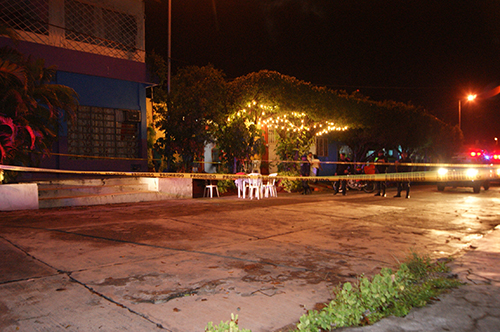Mexico City, July 22, 2016–Mexican federal authorities must conduct a credible and thorough investigation into the July 20 killing of Pedro Tamayo Rosas, a Veracruz journalist who was shot while under the protection of state authorities, the Committee to Protect Journalists said today.
Tamayo, 43, was shot in front of his wife, outside their home in the town of Tierra Blanca, in the eastern Mexican state of Veracruz, by unknown assailants. He died on the way to a nearby hospital, according to media reports. At the time of the attack, the freelance correspondent for the regional newspaper El Piñero de la Cuenca and news website Al Calor Político was enrolled in a Veracruz state-sponsored protection program for journalists who have been threatened and was under police protection after temporarily fleeing Veracruz earlier this year. Colleagues and authorities were unable to tell CPJ if the threats were in relation to his work.
“It is outrageous that a journalist who was under the protection of state police in Veracruz because of threats has been murdered in front of family,” said Carlos Lauría, CPJ Americas senior program coordinator, in New York. “The state of Veracruz is the most lethal place for the press in the Western hemisphere, and state authorities have shown themselves to be unwilling and incapable when it comes to solving the murders of journalists.”
According to initial law enforcement and news reports, a black vehicle pulled up to Tamayo’s residence at approximately11 p.m. At the time, the journalist was sitting outside by a food stand that his wife runs from their home, a friend of the family’s told CPJ. Two occupants of the car approached Tamayo and spoke with him briefly, then shot him at short range multiple times before fleeing.
In an interview with CPJ, Veracruz state Attorney General Luis Ángel Bravo said that the victim died of “at least” 10 bullet wounds while in an ambulance on his way to the hospital, and that “more than 10” 9-millimeter bullet shell casings had been found at the crime scene. He said initial investigations suggest that the suspect’s car had four occupants.
“Our main line of investigation is focused on the victim being killed because of his work as a journalist,” Bravo told CPJ in a telephone conversation yesterday afternoon. “But we are not disregarding other possible motives.” Bravo said he was unaware of any threats Tamayo may have received in recent days or weeks, citing the ongoing investigation.
As part of the state protection program, police checked in on Tamayo on a daily basis. Bravo told CPJ that there was record of a state police patrol checking in with Tamayo in the morning of the day he was killed, but he did not provide further details. A close friend and colleague, who asked to remain anonymous because of fear of reprisal, told CPJ the police patrol did not show up on the day of the attack.
Tamayo’s colleague said that the journalist had worked with Veracruz law enforcement as an informant. “He would provide law enforcement with information about organized crime he gathered while he was working as a reporter,” the colleague told CPJ. “It is not an uncommon phenomenon in Veracruz, though not openly spoken about.”
Bravo confirmed to CPJ that there was a “registry of a professional relationship” between Tamayo and state law enforcement, but said he was unable to provide more details as to what the relationship entailed.
The working relationship with state authorities ended after Tamayo fled Veracruz temporarily on January 25 following death threats, his colleague told CPJ. The colleague did not specify what the threats were related to. He said that Tamayo, his two sons, and his daughter-in-law found refuge in the state capital of Xalapa for 40 days and then spent another two weeks in Tijuana, in the state of Baja California, before returning to Tierra Blanca on March 8.
According to federal human rights sub-secretary Roberto Campa, interviewed yesterday by Mexico City newspaper Reforma, at the time Tamayo was offered the chance to enroll in the federal mechanism to protect journalists and was warned that it was still too dangerous for him to return to Tierra Blanca, but that the journalist refused. Tamayo’s colleague said he was unaware of such an offer being made to the journalist.
Tamayo reported mostly on crime, social issues, and protests. According to Al Calor Político, Tamayo’s last report was on the murder of a regional police commander and five others in the region.
“He covered news about crime and police operations,” Roberto Hernández, editor of El Piñero de la Cuenca, told CPJ yesterday. “I know he had received numerous threats in the past, but he never specifically discussed them with me.”
Veracruz is one of Mexico’s most violent states. A number of organized crime groups have been involved in bloody gangland warfare over lucrative drug and human trafficking routes. Journalists working in Veracruz told CPJ yesterday that Tierra Blanca is one the state’s most dangerous cities due to its location near a railroad, making it a strategic hub for criminal gangs.
“We urge President Enrique Peña Nieto to put the full weight of his administration into ending the vicious cycle of violence and impunity that is decimating the local media,” added CPJ’s Lauría.
At least six reporters have been killed in Veracruz in direct relation to their work since Governor Javier Duarte Ochoa assumed office in 2010, according to CPJ research. CPJ is investigating a further nine cases, including Tamayo’s, to determine if the journalists were killed in direct retaliation for the work.
